I’ve dewlt a bit on Gothic cathedrals and Khmer architecture. What was happening in India at the same time?
Indians too were building temples that expressed views of the whole universe, and their creations could flap wings with anyone else’s.
The Keshava (a name for Krishna) temple at Somnathpur was built near Mysore, Karnataka by a dynasty called the Hoysalas. They originally came from the hills in the western Ghats, and they established a small kingdom west of modern Bangalore. They grew into one of the largest states in southern India in the 12th century, and began to consolidate their power with temples as ornate as jewel boxes. Somnathpur’s shrine is the best preserved.
The main building (above) consists of a central hall (which the door in the middle enters), and three shrines–one on each side, and one at the far end. The main shrine was for Keshava. On the surface, this form is a bit similar to Gothic cathedrals’ cross shape, with the nave leading to the two transepts and the choir at the far end. But,
Gothic cathedrals have a pronounced linear plan, which leads you from the entrance to Jesus at the far end, and its sculpture and stained glass windows illustrate Biblical stories in a way which makes Jesus’ life central. But the Keshava temple gives you an abundance of forms that emanate in every direction. Each shrine is within a star-shaped tower (above), and the whole building is surrounded by an ambulatory.
And the towers are partitioned into so many shapes and sculptures that the main effect is sheer abundance, rather than a single line with clear divisions between domains, which you can see in Chartres Cathedral. And I do mean abundance–
The bottom of the main building has 6 levels of friezes. Each one is so intricate that you can feel as though you’re looking at several jewel boxes within a jewel box. The bottom row contains elephants, and horsemen strut their stuff in the next. Above them is a line of scrolls. The 4th panel has images from stories about Vishnu, and many are from the Ramayana. The pilasters in the next level are so intricate that they seem to be the opposites of Greek temples’ clear columns.
But the abundance hardly stops there. Just above those friezes, ornate carvings of gods surround the temple. Forms inside the temple are equally intricate, and surrounding ambulatory has 64 cells, which were dedicated to different deities. This abundance of gods reflects things about Indian narratives. Whereas the medieval West focused on one theology with a single story line from the Old Testament to the New Testament, Indian narratives expanded into many eras and gods’ lives. Vishnu incarnated 10 times, and Krishna was one of his avatars.
Above is one of the temple’s many statues of Vishnu. He doesn’t stand out as a person nearly as much as sculptures do on many Gothic cathedrals.
Gothic cathedrals have many sculptures of Biblical figures, but in the 13th century, when the Keshava temple was built, they stand out as distinct people. Yeah, they’re part of the universal Christian narrative, but they seem to take on lives of their own. But the statue of Vishnu above them, and the other statues on the Keshava temple, are surrounded by so many ornate motifs that all the forms seem to dissolve into a larger metaphysical background.
And all the components of the Keshava temple seem to do the same. They’re far too numerous for the brain to process in one view. They immerse you in this vast metaphysical field from which innumerable gods and natural forms emanated. This vastness isn’t conceived as a line as much as an enormously long chain of cycles of creation and dissolution. Too many life forms emanate to be put into one line–all populate an extremely vast universe, and then dissolve. All share the same metaphysical unity. The temple’s wealth of forms helps you appreciate the unity of all life.
I was alone in there with a young man, who said, “This is too good!” We had the whole temple to ourselves, and we savored its abundance together. India’s old temples still provide models of reality for modern Indians. If you go to India on business, go to one, linger for a while, and see a different view of reality with ancient roots.

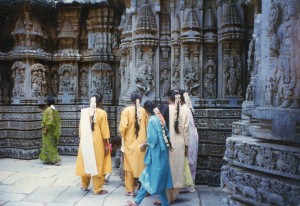
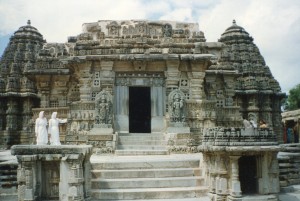
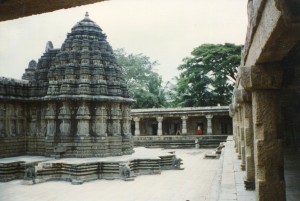
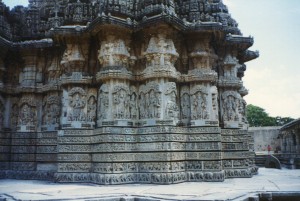
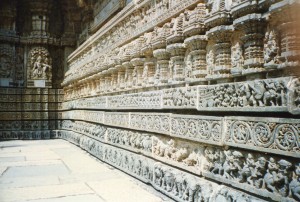
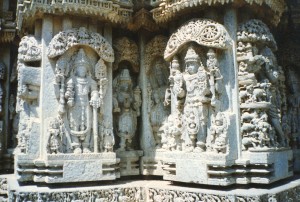
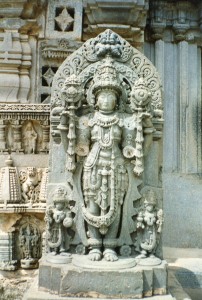
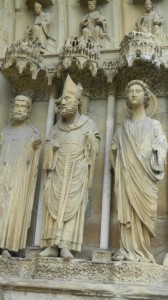
Comments on this entry are closed.